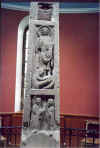|
Ruthwell

It is easy
to unknowingly pass by the village of Ruthwell in the
sense that you need to know where it is and why you should
visit. Let me put you in the picture. Ruthwell is a
village on the minor road (B724) that skirts the
coast of the Solway Firth. If coming from England the road
runs parallel to the main Stranraer road (A75) from Gretna
Green to Dumfries. Why you should visit – is the
opportunity to see the magnificent Runic Cross that dates
from the early 8th century.
 The The
cross is thought to have been carved while the area was
located in the ancient Kingdom of Northumbria and a
symbol of the Latin church (Rome) as opposed to the Celtic
church. At the end of the 7th century there was a revival
of stone carving and efforts were made to do so `in the
Roman manner.` As it happened the carvings soon took on
their own distinctive character and the twirling vine
motif was that of Northumbria. The work itself was
probably commissioned by the burning enthusiasm of its
converts and may have been a protest against Roman
domination. of the church. Some authorities suggest that
it was set up at the behest of Colman, Bishop of
Lindisfarne and, importantly, it made the church of St
Columba and St Aidan the first Protestant church in the
British Isles. But this ignores the presence in 342 AD of
St Ninian and his
Candida Casa at Wigtown.
The cross
may have been in a monastery or perhaps used as a teaching
aid when the monks would relate the story of Christ by
reference to the many carvings on it. There are
inscriptions in two languages and two alphabets. The south
and north faces are inscribed in Latin and relate to
panels next to it.
The
engravings are :
On the South side:
 St John the Evangelist and the Eagle St John the Evangelist and the Eagle
The Archer
The Visitation or Salutation of Mary
and Elisabeth
The washing of the Saviours feet
The healing of the blind man
The Annunciation
The Crucifixion
On the
North side:
The bird – possibly the Dove of Peace
Two evangelists
John the Baptist with the Agnus Dei
Christ in Majesty, standing on the heads of swine –
– believed to represent victory over
vice and uncleanliness.
Meeting of Paul and Antony in the desert
The Flight into Egypt.
The other
two sides are written in the ancient runes and tell the
story of the Crucifixion as seen by the Cross. The runes
were deciphered in 1840 as being an Anglo Saxon poem –
“The Holy Rood: a Dream” written by the monk Caedmon in
the seventh century who was a herdsman at the Abbey of
Whitby.
The
translation by a Professor Stephens goes thus:
Girded
him then
God Almighty
When he would
Step on the Gallows.
Fore all mankind
Mindfast, fearless,
Bow me durst I not.
Rood was
I reared now
Rich King heaving
The Lord of Light realms
Lean me durst I not.
Us both they basely mocked and handled,
Was I there with blood bedabbled,
Gushing grievous from his dear side
When his ghost he had uprendered.
Christ
was on Rood tree,
But fast from afar
His friends hurried
to aid their Atheling (prince).
Everything I saw.
Sorely was I with sorrows harrowed.
Yet humbly I inclined
To the hands of his servants
Striving with might to aid him,
With streals (shafts) was I. All wounded
Down they laid him limb weary,
O`er his lifeless head then stood they,
Heavily gazing at Heaven`s chieftain.
The cross
has led a chequered life and recent history is that it was
in the church at Ruthwell about 1640. However, the General
Assembly of

the Church of Scotland ordered the removal and destruction
of idols from the churches. The then minister, Rev. Gavin
Young, reluctantly complied but preserved much of it by
burying within the kirk and using portions for benches. In
1771 the two largest pieces were taken outside and it was
in 1802 that the Rev. Henry Duncan had the pieces, along
with another piece he had found, erected in his garden.
The incomplete cross stayed there until 1823 when the Rev
Duncan commissioned repairs to be made. The cross was
finally restored to the church and placed in the well that
was specially constructed apse in 1887, under the care of
the Rev. James McFarlan.
The story
of Ruthwell does not stop at the Cross as the Rev. Henry
Duncan was more than a minister but also founder of the
Savings Bank movement.
But please take care when using the steps by the church gate to mount or dismount from your horse !

Next
Dumfries to Kirkcudbright
|